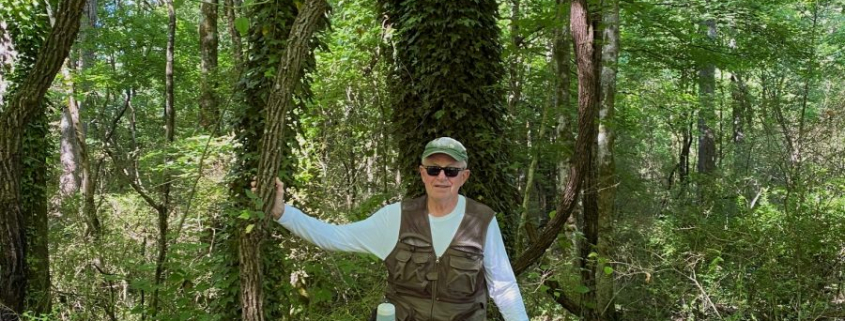Early Summer on the Richard Martin Rails to Trail
May 17, 2022, I hiked a section of the Richard Martin Rails to Trail in Limestone County Alabama with Chris Stuhlinger, fellow Board member of OLLI (Osher Lifelong Learning Institute) at the University of Alabama in Huntsville. We were doing a dry run for a hike we’ll be co-leading for OLLI June 11, 2022.
Introducing the Trail
We parked at Elkmont, Alabama (old Tennessee and Alabama depot below left), which sits midway between the trail’s southern terminus just north of Athens and its northern end at Veto, AL on the Tennessee line.
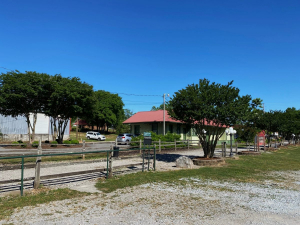
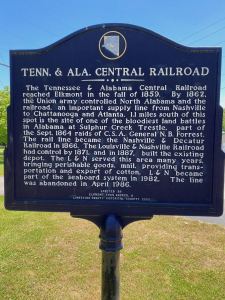
I’ve biked the entire trail (22 mile round trip) multiple times prior to my November 2021 left shoulder replacement surgery. Our recent hike took us just 1.1 miles south to the the National Historic Park site of the Civil War Battle of Sulphur Creek Trestle. The trail is gravel and mostly shaded. A few benches (one with Chris) sit along the trail. The trees trailside have grown since the Tennessee and Alabama RR (TA RR) abandoned the line in 1986.

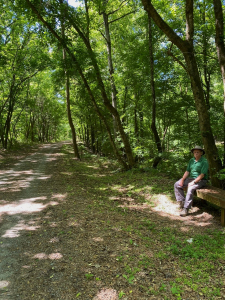
Our trek, as I recall, had just a single bend before we reached the battle site, where Chris stands below right reading National Park Service interpretive signs.
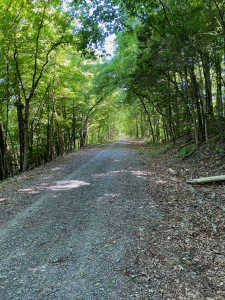
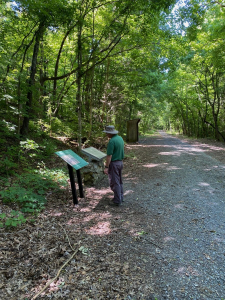
I won’t offer much explanation of the battle. The internet has lots of detail. I believe you can read the general summary below left. The actual trestle from a January 1, 1864 photo below right, just nine months before the Confederate attackers burned it to the ground.
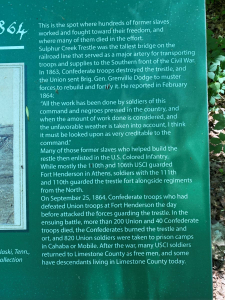
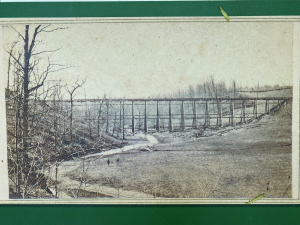
Rather than rebuild the wooden structure, engineers constructed a limestone viaduct across the creek, and filled the crossing above it with a sound earthen and stone base to support the railbed.

I recorded this three minute video at the battle site to give you a feel for the terrain and the trail.
The Nature of the Trail
Our hike emphasized the intersection of human and natural history. The trail passes through what some would view as wild country, rich with diverse trees, plants, and critters, as well as several stream crossings, a swamp, and occasional meadows along its full eleven mile length from Athens to Veto. Even the segment Chris and I walked could be viewed as wild. However, there is a big difference between wild and wilderness, the kind that meets the 1964 US Wilderness Act definition: an area where the earth and its community of life are untrammeled by man, where man himself is a visitor who does not remain. The trail corridor is anything but untouched. Crews maintained the rail line for nearly 130 years as trains passed daily or more often, belching smoke and breaking the silence. Agricultural pursuits and timber cutting in the area changed the face of the land repeatedly. A modern country road parallels the line in places. Now, an appearance of wildness, yes. Wilderness? Not even close!
Let’s examine some of the wildness along the stretch we hiked. I’ve frequently mentioned in these Great Blue Heron Posts my fascination with forest vines. Muscadine grape vines greeted us along the trail, secure in their main canopy occupancy high above us.
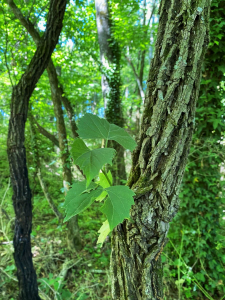
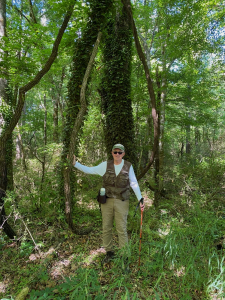
I don’t often encounter red mulberry. The US Forest Service notes the principal value of this species:
The wood is of little commercial importance. The tree’s value is derived from its abundant fruits, which are eaten by people, birds, and small mammals.
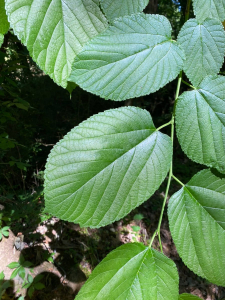
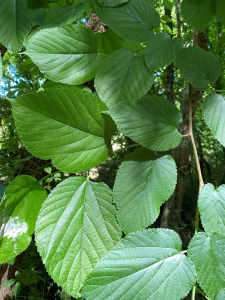
An online NC State University Cooperative Extension bulletin describes the spiny formidable plant below:
Aralia spinosa, commonly called devil’s walking stick or Hercules’ club, gets its common name from the stout, sharp spines found on its leaf stalks, stems and branches. This is a large, upright, suckering, deciduous shrub that typically grows to 10-15’ tall, but infrequently grows as a small flat topped tree to as much as 35’ tall. In its native range in the eastern U.S., it is commonly found in wood margins, fields and pastures as well as a forest or natural area at the edge of woods or along streams in moist woods.
I include mention and photos only because of this species’ odd name and thorny character.
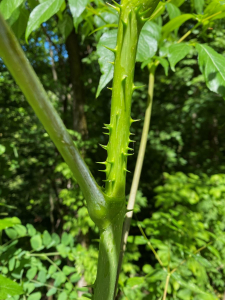
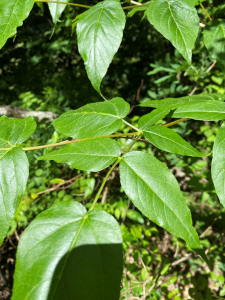
An online Penn State Extension publication says this about Japanese honeysuckle (photo below):
It was brought to the United States, along with other non-native honeysuckles as an ornamental plant. Like many invasive species, Japanese honeysuckle likes to grow along the edge of a disturbance (wood edge, path). It prefers full sun, but it can grow in shaded environments. This plant reproduces by seed or from the runners that can root at the node. Growth is aggressive, and the plant will climb over other desirable plant material. In warmer areas, it is semi-evergreen to evergreen. The white, ornate flowers appear in the spring and are very fragrant.
I recall as a child separating the petals and tasting its sweet fragrant nectar.
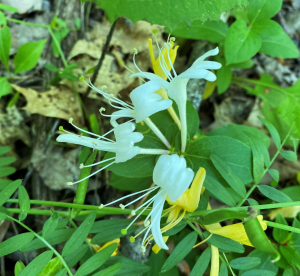
The Missouri Department of Conservation describes musk thistle (photo below) in a most unflattering manner:
Musk thistle is found in waste ground, old fields and pasture, and along roads and railroads. It is a major weed in range and pasture land, a nuisance pest along rights-of-way, and a looming nightmare for lands in conservation reserve programs. It can invade native grasslands, even where existing dense prairie vegetation exists.
However, I consider its flower quite attractive. I applaud its ability to occupy and even flourish on waste ground. In effect, the immediate buffer along the abandoned rail line did qualify as incredibly abused…smoke and its associated by products; herbicide, fire, and periodic mowing to keep vegetation at bay; diesel by-products once the railroad gave up coal burning steam engines. I doff my hat to this intrepid survivor.
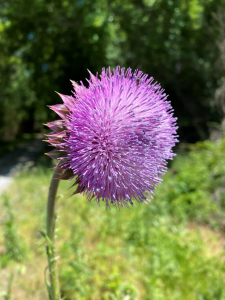
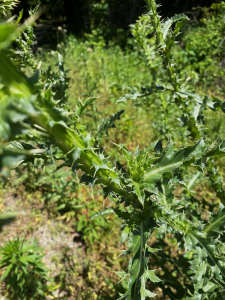
Sometimes a Name Speaks Volumes
Constantly alert for our friends in the fungi kingdom, I spotted this dog vomit slime mold on the cut end of a branch that had fallen across the trail. The US Fish and Wildlife Service reports:
The dog vomit slime mold, also known as scrambled egg slime, is named after its distinct appearance.
I prefer the scrambled egg moniker! I’m reminded that the orange roughy, a choice edible deep sea fish, once went by the name slimehead! So, a name means a great deal. I challenge you to find slimehead on the menu of any seafood restaurant!
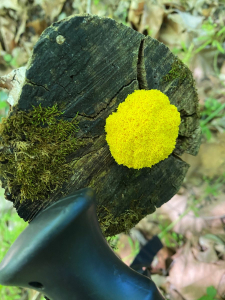
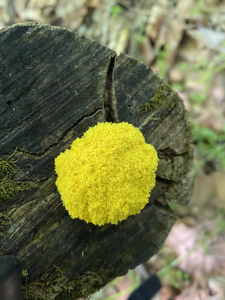
So, we’ve taken a short trip along the intersection of human and natural history. I’ve said often that every wild place has its tale. I can read some elements of the story from evidence in plain sight: vegetation, landscape, and remnant human artifacts and infrastructure. Other bits and pieces emerge only with interpretive signage. I hold that imagination also helps. Every time I bike the trail, I pause at the trestle site. My mind hears echoes of the sounds of battle, senses the agony of the wounded, and feels the heat of burning trestle beams. That day of violent engagement occurred 158 years ago, a seeming long time ago.
Yet, in the vast sweep of time our Earth has occupied its third-rock position, 158 years is nothing. John McPhee’s Basin and Range reminds us of our fleeting existence:
With your arms spread wide to represent all time on Earth, look at one hand with its line of life. The Cambrian begins at the wrist, and the Permian extinction is at the end of the outer palm. All of the Cenozoic is in a fingerprint, and in a single stroke with a medium-grained nail file you could eradicate human history.
I offer that context to remind us that life and society are fleeting and fragile. A violent Civil War engagement 158 years ago (the geologic blink of an eye) was not the last chapter in the saga of human and societal development. Carl Sagan reminded us that we are alone and solely responsible for our own future:
Our planet is a lonely speck in the great enveloping cosmic dark. In our obscurity, in all this vastness, there is no hint that help will come from elsewhere to save us from ourselves.
Our hike along the Richard Martin Trail reminded me that Nature is resilient. Are we? I don’t want dog vomit slime mold to enter a future without curious naturalists to study and, strangely enough, admire it.
Thoughts and Reflections
I offer these observations:
- The intersection of human and natural history provides a fascinating point of study and contemplation.
- Nature is a master at healing wounds.
- Every wild place tells a tale worthy of exploration.
Inhale and absorb Nature’s elixir. May Nature Inspire, Inform, and Reward you!
Note: All blog post images created & photographed by Stephen B. Jones unless otherwise noted. Please circulate images with photo credit: “©2022 Steve Jones, Great Blue Heron LLC. All Rights Reserved.”
Another Note: If you came to this post via a Facebook posting or by an another route, please sign up now (no cost… no obligation) to receive my Blog Post email alerts: http://eepurl.com/cKLJdL
And a Third: I am available for Nature-Inspired Speaking, Writing, and Consulting — contact me at steve.jones.0524@gmail.com
Reminder of my Personal and Professional Purpose, Passion, and Cause
If only more of us viewed our precious environment through the filters I employ. If only my mission and vision could be multiplied untold orders of magnitude:
Mission: Employ writing and speaking to educate, inspire, and enable readers and listeners to understand, appreciate, and enjoy Nature… and accept and practice Earth Stewardship.
Vision:
- People of all ages will pay greater attention to and engage more regularly with Nature… and will accept and practice informed and responsible Earth Stewardship.
- They will see their relationship to our natural world with new eyes… and will understand more clearly their Earth home.
Tagline/Motto: Steve (Great Blue Heron) encourages and seeks a better tomorrow through Nature-Inspired Living!
Steve’s Three Books
I wrote my books Nature Based Leadership (2016), Nature-Inspired Learning and Leading (2017), and Weaned Seals and Snowy Summits: Stories of Passion for Place and Everyday Nature (2019; co-authored with Dr. Jennifer Wilhoit) to encourage all citizens to recognize and appreciate that every lesson for living, learning, serving, and leading is either written indelibly in or is powerfully inspired by Nature.
I began writing books and Posts for several reasons:
- I love hiking and exploring in Nature
- I see images I want to (and do) capture with my trusty iPhone camera
- I enjoy explaining those images — an educator at heart
- I don’t play golf!
- I actually do love writing — it’s the hobby I never needed when my career consumed me
- Judy suggested my writing is in large measure my legacy to our two kids, our five grand kids, and all the unborn generations beyond
- And finally, perhaps my books and Blogs could reach beyond family and touch a few other lives… sow some seeds for the future


All three of my books (Nature Based Leadership; Nature-Inspired Learning and Leading; Weaned Seals and Snowy Summits) present compilations of personal experiences expressing my (and co-author Dr. Wilhoit for Weaned Seals and Snowy Summits) deep passion for Nature. All three books offer observations and reflections on my relationship to the natural world… and the broader implications for society. Order any and all from your local indie bookstore, or find them on IndieBound or other online sources such as Amazon and LifeRich.

